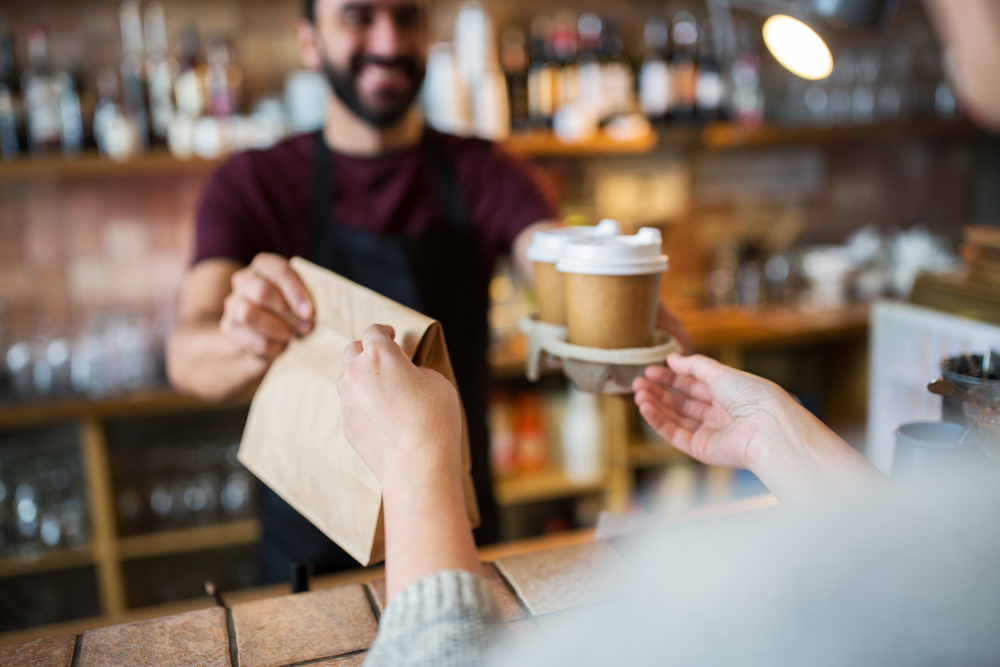Unwrapping the Future of Paper Cups
By Anttoni Taimela · 21. June 2024
What does the future of paper cups look like in an environmentally conscious world?
In the next few minutes, we will explore how paper cups are evolving beyond their traditional role to meet the rising demand for sustainable solutions.
With heightened consumer awareness and impending regulations, the industry stands at a crossroad between innovation and environmental stewardship, a balance that will define the future of paper cups.
Evolving Market Projections for Paper Cups 📈

beautiful woman holding coffee paper cup
The paper cup, a staple of modern life found in office pantries, coffee shops, and vending machines, is riding a wave of growth that is projected to crest impressively by the end of the decade.
Valued at a substantial USD 17.81 billion in 2022, the paper cups industry is more than just a segment of the market; it is a phenomenon reflective of a society on the go.
As the hands of time move forward, so too does the size of this market, with an expected Compound Annual Growth Rate (CAGR) of 3.12% through 2028, pointing to a staggering anticipated market size of USD 42.64 billion by 2030.
This soaring trajectory is fueled by the undeniable convenience of disposable cups, which serve as both a boon for consumers seeking quick solutions and a challenge for those mindful of environmental implications.
Market Growth and Hot Beverage Domination ☕️
Picture the bustling streets early in the morning, with throngs of people cradling steaming paper coffee cups on their way to work.
This daily tableau underscores the global dominance of hot beverages, a segment that has historically driven the paper cup industry forward at a historical CAGR of 4.0% from 2018 to 2022.
The coffee cup, in its many forms, has become synonymous with modern life, catering to coffee drinkers who fuel their day with hot drinks served in a convenient vessel that has proven suitable for both hot and cold beverages.
The versatility of paper cups, coupled with the high demand from brands like Burger King and other fast-food giants, has solidified their place in the market, turning them into an indispensable part of the food packaging sector and a significant player in the overall market dynamics.
Sustainability as a Market Driver ♻️

sustainable paper cup
Today’s consumers are acutely aware of the environmental challenges facing our planet, and this consciousness is driving a shift in the supply chain towards sustainable solutions.
The ripple effect of this heightened environmental awareness is tangible in the marketplace, with a discernible inclination towards eco-friendly products that offer environmental benefits and align with broader sustainability goals.
As a result, the market dynamics are shifting, with a growing portion of the market size being claimed by sustainable packaging, a transformation that speaks volumes about the evolving ethos of the paper cups industry and its consumers.
Innovations Reshaping the Paper Cup Landscape 🔬
Innovation is the cornerstone of progress, and the paper cups industry is no exception.
Today’s paper cup is a marvel of modern engineering, incorporating bio-based materials like PLA to reduce reliance on traditional petroleum-based plastic cups.
These innovations are not merely incremental; they are revolutionary, offering improved durability that satisfies the market’s demand for better quality and performance.
Further enhancements in insulation properties ensure that your coffee cup keeps beverages at the desired temperature for longer, while smart cups with embedded technology are beginning to offer interactive experiences that tantalise the senses beyond taste.
Next-Gen Biodegradable Cups 🌽
In the vanguard of this revolution are the next-generation biodegradable cups, with PLA taking centre stage as the preferred bio-coating for disposable paper cups.
Derived from renewable resources like corn starch and sugar, PLA coatings are setting a benchmark in the industry for degradability and a reduced carbon footprint, surpassing traditional PE coated paper cups.
As the paper cups industry galvanizes to address the challenges of PLA’s limited supply and complex recycling process, efforts to make the recycling of these biodegradable cups more accessible and effective are gaining traction.
This aligns perfectly with the market’s pivot towards sustainability, as PLA-coated cups resonate with consumer demand for products that allow them to sip conscientiously.
Design Breakthroughs in Reusability 🔄
The push towards a more sustainable future is evident in the design breakthroughs aimed at reusability.
Circular cups, designed to endure, can withstand over 500 cycles of use, challenging the very concept of single-use plastics.
Such innovations are not just about reducing waste; they are about reimagining the lifecycle of the paper cup, transforming it into a reusable cup that can accompany coffee drinkers on countless morning commutes as their own reusable coffee cup.
By extending the utility of the cup, these design advancements are cultivating a future where sustainable solutions and sustainable packaging become synonymous with everyday convenience.
The Rise of Circular Economy in Coffee Shops ☕

coffee shop manager serving customer coffee with paper bag and paper cup
The conversation around sustainability in the paper cups industry is incomplete without addressing the role of coffee shops in fostering a circular economy.
With the realization that the era of single-use plastic must come to an end, coffee shops are spearheading the adoption of reusable and returnable solutions.
This transition is not merely a response to consumer demand; it’s a movement driven by innovation and a commitment to zero waste principles that are reshaping the very fabric of the coffee shop experience.
Through initiatives like deposit return schemes and collaborations with technology firms for easy returns, coffee shops are becoming pivotal in the journey from single use to reuse, setting a precedent for other industries to follow.
From Single Use to Reuse 🔁
Diving deeper into the shift from single use to reuse, it becomes evident that coffee shops are not just encouraging the use of reusable cups; they are actively developing alternatives to disposable coffee cups that are compostable, biodegradable, and aligned with the desires of environmentally conscious consumers.
The evolution of the paper cup has given rise to innovative coffee cup recycling options, such as the ButterflyCup, which aims to streamline the recycling process and integrate it seamlessly into the daily routine of coffee drinkers.
This proactive approach by coffee shops is instrumental in reducing waste, influencing the supply chain, and contributing to a more sustainable future.
Recycling Initiatives Taking Hold 🌍
As the paper cups industry marches towards sustainability, paper cup recycling initiatives are taking root, showcasing the potential for effective waste management.
Nationwide recycling services, such as Biffa in the UK, exemplify how systematic efforts can lead to significant improvements in handling the recycling of paper cups.
Yet, the path is not without challenges; with variability in recycling strategies and infrastructure, many potentially recyclable cups find their way to landfills instead of recycling facilities.
Despite these hurdles, the industry remains steadfast in its commitment to reducing plastic waste, with recycling serving as a cornerstone of sustainability initiatives, aiming to close the loop on the lifecycle of paper cups.
Consumer Behavior and Brand Value Alignment 💡
Consumer behaviour is a powerful force, capable of influencing brands to align their values with those of their customers.
As businesses incorporate more sustainable packaging options, they tap into a vein of global consumer sentiment that prioritises environmental integrity.
However, there exists a paradox; despite expressing a desire for eco-friendly products, consumer purchasing behaviour often belies these sustainable preferences.
Brands that embrace green practices are not only attracting environmentally conscious customers but are also cultivating loyalty and enhancing their brand image through the subtle marketing power of branded paper cups.
By leveraging the tactile connection between the consumer and the brand, businesses are transforming everyday users into brand ambassadors, reinforcing the brand’s identity with every sip taken from a branded coffee cup.
The Role of Consumer Choice 🌱
The role of consumer choice cannot be overstated in its ability to drive the market towards environmentally friendly products.
As consumers become more informed and prioritise environmental responsibility, their preferences are propelling demand for sustainable packaging in the food industry, including the paper cups sector.
The choices made at the point of purchase reflect a growing environmental awareness that translates into a tangible push for eco-friendly products, influencing the growth of sustainable packaging materials in the industry.
When consumers vote with their wallets for sustainability, they signal to the market that the future of paper cups is not just in functionality but in aligning with the values of a planet-conscious public.
Summary
As we seal the lid on our exploration of the paper cups industry, it’s evident that this seemingly simple product encapsulates a complex narrative of growth, innovation, sustainability, and consumer consciousness.
From the robust market projections to the ground-breaking innovations, and the regulatory environment to the shifting consumer behaviours, paper cups are emblematic of a society striving for balance between convenience and responsibility.
The future of paper cups is unfolding before us, promising a blend of technological advances and environmental stewardship that will redefine our coffee-drinking experience and our impact on the world.
Frequently Asked Questions
What is driving the growth of the paper cups market?
The convenience of disposable cups, increasing demand for hot beverage cups, and heightened environmental consciousness are driving the growth of the paper cups market. These factors have led consumers to choose sustainable products.
How are innovations in materials like PLA beneficial to the paper cup industry?
Innovations in materials like PLA are beneficial to the paper cup industry because they offer improved degradability and a reduced carbon footprint, aligning with consumer demand for environmentally responsible products. This helps in making the industry more sustainable.
What role do coffee shops play in promoting a circular economy?
Coffee shops play a crucial role in promoting a circular economy by implementing reusable and returnable solutions, as well as innovative recycling programs, to minimise waste and encourage sustainability.
How are regulations affecting the paper cups industry?
Regulations are driving innovation in the paper cups industry, prompting the redesign of disposable cups and the development of new environmentally compliant products, as well as the introduction of bans on single-use cups in certain regions. This is leading to increased innovation within the industry.
Why is there a paradox between consumer attitudes and purchasing behaviour regarding sustainable products?
While many consumers have positive attitudes towards eco-friendly products, their purchasing behaviour may not align with these preferences due to factors like convenience, cost, and availability of sustainable options. It’s essential to consider these factors when analysing consumer behaviour.

